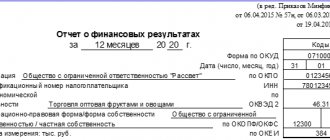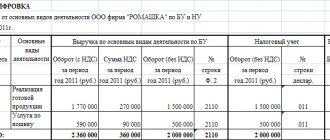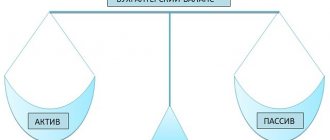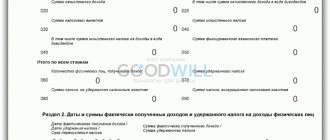Income Statement Line
Return to Financial Result
Line 2110 “Revenue” reflects: credit turnover on account 90 “Sales” minus debit turnover on subaccount 90 “Value Added Tax” minus debit turnover on subaccount 90 “Excise Taxes”. An organization's income is recognized as an increase in economic benefits as a result of the receipt of assets (cash, other property) and (or) repayment of liabilities, leading to an increase in the capital of this organization, with the exception of contributions from participants (owners of property).
Service Temporarily Unavailable
Line 2120 “Cost of sales” reflects: debit turnover in subaccount 90 “Cost of sales” minus turnover in the debit of subaccount 90 “Cost of sales” from the credit of account 26 “General expenses” minus turnover in the debit of subaccount 90 “Cost of sales” from the credit of account 44 "Sale expenses." An organization's expenses are recognized as a decrease in economic benefits as a result of the disposal of assets (cash, other property) and (or) the occurrence of liabilities, leading to a decrease in the capital of this organization, with the exception of a decrease in contributions by decision of participants (owners of property).
Line 2100 “Gross profit (loss)” reflects: line 2110 “Revenue” minus line 2120 “Cost of sales”.
Line 2210 “Business expenses” reflects: turnover in the debit of subaccount 90 “Cost of sales” from the credit of account 44 “Sales expenses”.
Line 2220 “Administrative expenses” reflects: turnover in the debit of subaccount 90 “Cost of sales” from the credit of account 26 “General expenses”.
Line 2200 “Profit (loss) from sales” reflects: line 2100 “Gross profit (loss)” minus line 2210 “Commercial expenses” minus line 2220 “Administrative expenses”. This amount should be identical to the result generated in subaccount 90 “Profit (loss) from sales.”
Line 2320 “Interest receivable” reflects: turnover on credit of subaccount 91.1 “Other income” from the debit of interest receivable accounts.
Line 2330 “Interest payable” reflects: turnover to the debit of subaccount 91.2 “Other expenses” from the credit of the interest payable accounts.
Line 2340 “Other income” reflects: credit turnover in subaccount 91.1 “Other income” (except for income included in lines 2310 “Income from participation in other organizations” and 2320 “Interest receivable”) minus turnover in the debit of subaccount 91.2 “ Other expenses" from the credit of account 68 "Calculations for taxes and fees" (in terms of value added tax, excise taxes, export duties accrued upon sale).
Line 2350 “Other expenses” reflects (if not reflected in other lines): turnover in the debit of subaccount 91.2 “Other expenses” from the credit of various accounts (except for interest payable, as well as VAT, excise taxes and other similar mandatory payments).
Line 2300 “Profit (loss) before tax” reflects: line 2200 “Profit (loss) from sales” plus line 2310 “Income from participation in other organizations” plus line 2320 “Interest receivable” minus line 2330 “Interest payable” plus line 2340 “Other income” minus line 2350 “Other expenses”. This amount should be identical to the result generated in subaccount 99 “Financial results of operations before tax.”
Line 2410 “Current income tax” reflects the amount of income tax generated according to tax accounting data for the reporting (tax) period and reflected in the accounting records in account 68 plus/minus turnover in subaccount 99 “Conditional income tax expense/income” » plus/minus the difference between credit and debit turnover in subaccount 99 “Fixed tax liabilities and assets” plus/minus the difference between debit and credit turnover in account 09 “Deferred tax assets” plus/minus the difference between credit and debit turnover in account 77 “ Deferred tax liabilities."
According to line 2421 “incl. permanent tax liabilities (assets)” reflects information on the balance of permanent tax liabilities (assets). Credit turnover under subaccount 99 “Fixed tax liabilities (assets)” minus debit turnover under subaccount 99 “Fixed tax liabilities (assets)”.
Line 2430 “Changes in deferred tax liabilities” reflects information about changes in the amount of deferred tax liabilities recognized in accounting in accordance with the requirements of PBU 18/02.
Credit turnover on account 77 “Deferred tax liabilities” minus debit turnover on account 77 “Deferred tax liabilities” (Without taking into account debit turnover on account 77 in correspondence with account 99 “Profits and losses”).
Line 2450 “Changes in deferred tax assets” reflects information about changes in the amount of deferred tax assets recognized in accounting in accordance with the requirements of PBU 18/02. Debit turnover on account 09 “Deferred tax assets” minus credit turnover on account 09 “Deferred tax assets” (Without taking into account credit turnover on account 09 in correspondence with account 99 “Profits and losses”).
Line 2400 “Net profit (loss)” reflects information about the organization’s net profit (loss), i.e. about retained earnings (uncovered loss). When preparing interim reporting: balance on account 99 “Profits and losses” (in terms of net profit (loss)). When preparing annual reports: turnover on account 99 “Profits and losses” in correspondence with account 84 “Retained earnings (uncovered loss)”.
Line 2500 “Cumulative financial result of the period” indicates for reference an indicator representing the net profit (loss) of the organization, adjusted for the results from the revaluation of non-current assets and other operations not included in the net profit (loss) of the reporting period. Line 2400 “Net profit (loss)” plus/minus line 2510 “Result from the revaluation of non-current assets, not included in the net profit (loss) of the period” plus/minus line 2520 “Result from other operations, not included in the net profit (loss) period."
Blog
To calculate profits and losses, account 99 is provided. If in the balance sheet on account 99 we see a debit balance, this means the final loss of the company, a credit balance - the net profit of the company.
Profit before tax is the positive financial result of a company’s activities (the difference between income received and expenses) before the deduction of income tax.
An excess of expenses over an organization's income means that the organization is operating at a loss.
The Statement of Financial Results reflects the amount of profit (loss) before tax according to accounting data.
Profit (loss) before tax is calculated in steps:
- 1) Gross profit (loss) = Revenue (excluding VAT) – Cost of sales
According to the Turnover Balance Sheet, the calculation will look like this:
Gross profit (loss) = 90.1 “Revenue” - 90.3 “VAT” - 90.4 “Excise taxes” - 90.2 “Cost”
A positive result means profit, a negative result means loss. The amount of gross loss in the Statement of Financial Results is reflected in parentheses.
Related course
Advanced accountant
- 2) Profit (loss) from sales = Gross profit (loss with a minus sign) – Selling and Administrative expenses
According to the Turnover Balance Sheet, the calculation will look like this:
Profit (loss) from sales = Gross profit (loss with a minus sign) – 90.7 “Commercial expenses” – 90.8 “Administrative expenses”
The amount of loss on sales is shown in parentheses in the Income Statement.
- 3) Profit (loss) before tax = Profit (loss) from sales + Interest receivable - Interest payable + Other income - Other expenses
According to the Turnover Balance Sheet, the calculation will look like this:
Profit (loss) before tax = Profit (loss) from sales + 91.1 “Interest receivable” - 91.2 “Interest payable” + 91.1 “Other income” – 91.2 “Other expenses”
The amount of loss before tax is shown in parentheses in the Income Statement.
When preparing annual financial statements, account 99 “Profits and losses” is closed.
The final entry of December (reformation of the balance sheet) the amount of net profit of the reporting year from account 99 “Profits and losses” is written off to the credit of account 84 “Retained earnings (uncovered loss)”.
If there is a loss in the reporting year, the amount from account 99 “Profits and losses” is written off to the debit of account 84 “Retained earnings (uncovered loss)”.
/ “Accounting encyclopedia “Profirosta” 01/16/2020
Information on the page is searched for by the following queries: Corporate card, current account, accountant, sub-report, advance report, LLC Registration, Individual Entrepreneur Registration, taxes, application for LLC registration, application for opening an individual entrepreneur, opening an individual entrepreneur, opening an LLC, form P21001, exemption from payment state fees, Accountant courses in Krasnoyarsk, Accounting courses in Krasnoyarsk, Accountant courses for beginners, 1C:Accounting courses, Distance learning, Accountant training, Training courses Salaries and personnel, Advanced training for accountants, Accounting for beginners Accounting services, VAT declaration, Tax declaration profit, Accounting, Tax reporting, Accounting services Krasnoyarsk, Internal audit, OSN reporting, Statistics reporting, Pension Fund reporting, Accounting services, Outsourcing, UTII reporting, Accounting, Accounting support, Provision of accounting services, Accountant assistance, Reporting via the Internet, Preparation of declarations, An accountant is needed, Accounting policy, Registration of individual entrepreneurs and LLCs, Individual entrepreneur taxes, 3-NDFL, Organization of accounting, how to check, transport tax Krasnoyarsk, transport tax, response to the requirement of the Federal Tax Service, response to the requirement of regulatory authorities, control Federal Tax Service Inspectorate, on-site tax audit.
Balance sheet with accounts
This page shows the balance sheet with accounts. The accounts are shown according to the chart of accounts, which is also available on the website. This balance sheet has been prepared to facilitate understanding of the relationship between the accounting accounts and the balance sheet figures. In contrast to the regulated form in which enterprises prepare reports, a column has been added to the balance sheet indicating the accounting accounts, the balances of which can be reflected in one or another line of the balance sheet. To make it easier to understand, the decoding “including” has been added to some balance lines. So, for example, as can be seen below, the concept of “inventories” includes raw materials, work in progress, goods, etc.
Line 2300 “Profit (loss) before tax”
In the approved balance sheet form, this is one line and filling it out for beginners causes great difficulties. If a task requires filling out a balance sheet according to an approved form, then the “including” decoding lines must be summed up and the result included in the final line.
| ASSETS | |
| I. NON-CURRENT ASSETS | |
| Intangible assets | 04 — 05 |
| Research and development results | |
| Fixed assets | 01 — 02, 07, 08 |
| Profitable investments in material assets | 03 |
| Financial investments | 58, 59 |
| Deferred tax assets | |
| Other noncurrent assets | |
| Total for Section I | |
| II. CURRENT ASSETS | |
| Reserves | |
| including: | |
| Raw materials, supplies and other similar assets | 10, 15, 16 |
| Animals being raised and fattened | 11 |
| Costs in work in progress (distribution costs) | 20, 21, 23, 29, 44, |
| Finished products and goods for resale | 41, 42, 43 |
| Goods shipped | 45 |
| Future expenses | 97 |
| Other inventories and costs | |
| Value added tax on purchased assets | 19 |
| Accounts receivable | |
| including: | |
| Buyers and clients | 62, 76, 63 |
| Bills receivable | 62, 76 |
| Debt of subsidiaries and dependent companies | 58, 60, 62, 75, 76 |
| Advances issued | 60 |
| Other debtors | |
| Financial investments (excluding cash equivalents) | 58, 59 |
| Cash and cash equivalents | |
| including: | |
| Cash register | 50 |
| current accounts | 51 |
| foreign currency accounts | 52 |
| other funds | 55, 57 |
| Other current assets | |
| Total for Section II | |
| BALANCE | |
| PASSIVE | |
| III. CAPITAL AND RESERVES | |
| Authorized capital (share capital, authorized capital, contributions of partners) | 80 |
| Own shares purchased from shareholders? | 81 |
| Revaluation of non-current assets | |
| Additional capital (without revaluation) | 83 |
| Reserve capital | 82 |
| Retained earnings (uncovered loss) | 84 |
| Total for Section III | |
| IV. LONG TERM DUTIES | |
| Borrowed funds | 67 |
| Deferred tax liabilities | |
| Estimated liabilities | |
| Other obligations | |
| Total for Section IV | |
| V. SHORT-TERM LIABILITIES | |
| Borrowed funds | 66 |
| Accounts payable | |
| including: | |
| Suppliers and contractors | 60, 76 |
| Debt to the organization's personnel | 70 |
| Debt to state extra-budgetary funds | 69 |
| Debt to the budget | 68 |
| Advances received | 62, 76 |
| Other creditors | |
| revenue of the future periods | 98 |
| Estimated liabilities | |
| Other obligations | 75, 96 |
| Total for Section V | |
| BALANCE | |
Other income (expenses)
Line 2310 Income from participation in other organizations
- CT turnover 91.01 according to subconto:
- Income (expenses) associated with participation in other organizations;
- Income (expenses) associated with participation in Russian organizations;
- Income (expenses) associated with participation in foreign organizations.
Line 2320 Interest receivable
- CT turnover 91.01 for the subaccount “Interest receivable (paid)”.
Line 2330 Interest payable
- Dt turnover 91.02 under subconto “Interest receivable (payable)”.
Line 2340 Other income
- Kt turnover 91.01 for all other subcontos minus Dt turnover 91.02 VAT .
Line 2350 Other expenses
- Dt turnover 91.02 for all other subaccounts.
Line 2300 Profit (loss) before tax
- Row sum:
- page 2200 “Profit (loss) from sales”;
- page 2310 “Income from participation in other organizations”;
- page 2320 “Interest receivable”;
- page 2330 “Interest payable”;
- page 2340 “Other income”;
- page 2350 “Other expenses”.
Current income tax
Line 2410 Current income tax
- if PBU 18/02 applies:
- Dt account turnover 68.04.1 minus Kt account turnover 68.04.2 .
if PBU 18/02 does NOT apply: turnover Dt 99.01.1 with a score of 68.04.1.
Lines 2421 incl. permanent tax liabilities (assets), 2430 Change in deferred tax liabilities, 2450 Change in deferred tax assets are filled in if PBU 18/02 is applied.
Line 2421 incl. permanent tax liabilities (assets)
- rpm difference:
- Dt 99.02.3 Kt 68.04.2 – PNO;
- Dt68.04.2 Kt 99.02.3 – PNA.
Line 2430 Change in deferred tax liabilities
- rpm difference:
- Dt 68.04.2 Kt 77 – accrual of IT;
- Dt 77 Kt 68.04.2 – repayment of IT.
Line 2450 Change in deferred tax assets
- rpm difference:
- Dt 09 Kt 68.04.2 – accrual of ONA;
- Dt 68.04.2 Kt 09 – repayment of ONA.
Line 2460 Other
- other income and expenses not mentioned above are indicated.
Line 2400 Net profit (loss)
- Row sum:
- page 2300 “Profit loss before tax”;
- page 2410 “Current income tax”;
- page 2430 “Change in deferred tax liabilities”;
- page 2450 “Changes in deferred tax assets”;
- p.2460 “Other.”
Indicators and their interpretation
So, let's start filling out the form step by step.
The ODF itself is presented in the form of a table of 5 columns:
- Explanation number
- Indicator name
- Code assigned to this indicator
- Value in the reporting period
- Last year's value
If during the period no operations were carried out in the organization, then the lines for them in the Report are not filled in, not 0, but a dash is written.
Income and expenses from ordinary activities
These are the company’s revenues and expenses, as well as preliminary financial results, which are generated as a result of activities registered as the main one in OKVED. These articles include:
Analysis of indicators
- Revenue is receipts from activities recognized by the company as ordinary, i.e. the main payment received by the company for goods produced. It is definitely worth considering that VAT and excise taxes previously paid by the company on some types of goods are subtracted from the amount of revenue.
- Cost of sales is the value expression of the resources used in production. We will not consider in detail the names and numbers of the accounts through which these amounts are processed, since they are very clearly spelled out in the Chart of Accounts. Don't forget that the value must be indicated in parentheses.
- Gross profit (loss) is a calculated value, the amount of deviation between the first two points. If not everything went smoothly in the organization’s activities and the loss is calculated at this stage, then the amount is enclosed in parentheses.
- Commercial expenses - include costs for: packaging of products, transportation, commission to intermediaries, rental of premises during sales, promotion of goods, entertainment expenses, fees for the work of insurance companies, losses during storage according to the norms of natural loss, etc.
- Administrative expenses - you don’t need to rack your brains to understand that these are administration expenses. The organization has the opportunity to choose one of two accounting options, but it is necessary to register it in the Accounting Policy: completely as part of the UR - this line of the Report is filled in; are included in the cost of production, then this line is not filled in, and accordingly, the second point of the general financial structure increases.
- Profit (loss) from sales is an estimated value obtained by subtracting the previously indicated general and administrative expenses from gross profit. To confirm the correctness of the calculation of the indicator, compare it with the balance of the corresponding sub-account, allocated specifically for this coefficient on account 99; ideally, they should coincide.
Other income and expenses
These are the company's income and expenses as a result of activities that are not related to the main activity, they include:
Company income
- Income from participation in other organizations implies the company’s earnings on securities, funds received from shares, and property of third-party companies.
- Interest receivable leaves no room for misinterpretation, so we will not dwell on them in detail.
- Interest payable – similar to the previous indicator, does not require detailed explanation.
- Other income includes other income not previously stated. Income consists of: rent, leasing, from the provision of licenses, patents, from the sale of fixed assets, from management companies of third-party companies, earnings on the securities market, if counterparties do not comply with contractual terms - penalties, donations, exchange rate differences, interest on bank deposits, profit of previous years, expired credit debt, revaluation of investments.
- Other expenses mean expenses of the company not previously indicated in Form No. 2. Typically they include expenses from: rent, leasing, use of patents, licenses, sale of assets, depreciation of intangible assets, markdown of financial investments, charity, organization of events, holidays for the purpose of generating income, creating a reserve and others.
Financial results
Total items obtained by taking into account all the company's income and expenses.
Profit (loss) before tax - the name very well characterizes the essence of the indicator; it is this article that will be the basis for determining the amount of tax.
Current income tax is the amount of planned tax payments to the state. Differences in the fundamentals of accounting and the tax system have led to the emergence of different approaches to calculating this parameter. The final result, after its adjustment taking into account these contradictions, is declared by the organization. The company is required to highlight in its regulatory forms one of the selected accounting methods:
Analysis of results
- The tax is calculated arithmetically according to data taken from the balance sheet. The profit received by the company at the time of shipment of the goods is multiplied by the tax percentage - this is a conditional expense or income for this type of tax, which serves as the basis for calculating tax liabilities (assets) - IT (IT). There are two types of them: constants - are registered as part of the indicator under consideration in the case when the amounts will be taken into account only for accounting purposes; deferred differences are allocated separately in the financial financial statements due to the temporary nature of their occurrence; an explanation for them is given below.
- IT appears in accounting for internal use, they are constantly monitored, but their amount is not allocated separately.
Other – includes amounts that do not fit the parameters of other indicators. These may be fines, penalties, penalties issued by the Federal Tax Service for unfulfilled tax requirements.
Net profit (loss) is one of the most important indicators of financial profitability, which is the overall result of the activities of an organization or entrepreneur. This is the amount remaining at the disposal of the company after taxes and other payments have been paid, which is what the business was organized for. Net profit forms retained earnings for the entire period of activity.
Tax assets and liabilities
They include two articles that are formed as a result of different approaches to accounting and reporting submitted to the Federal Tax Service:
Tax obligations
- Changes in deferred tax liabilities are prescribed in the OFR by organizations that do not use the simplified tax system or UTII. Usually it is formed, for example, when when calculating depreciation in accounting, one amount is obtained, and in tax accounting - another. Another possible occurrence is that the company takes into account revenue at the time of shipment of goods to the buyer before actual payment. The value of this indicator in the OFR is the amount already taken into account in the current period, when the planned date of its receipt is moved to the next year. Enterprises independently choose one of two options: deferred liabilities are allocated as part of the tax, the amount of which is taken from accounting analytics; IT is not highlighted in a separate article.
- A change in deferred tax assets is a standard in its economic meaning opposite to IT, that part of the calculated tax that is planned to be paid in the future. This line is calculated as the product of such expenses by the tax rate, taken into account on the balance of account 09. Reasons for the dynamics of IT: differences in the calculation of depreciation, overpayment of the tax amount to the Federal Tax Service when it is not returned to the company, losses on the sale of property arising from differences in determining the date disposals.
Articles listed for reference
The result of the revaluation of non-current assets is formed by clarifying the value of the tangible and non-physical assets of the enterprise, taking into account the current market price for similar property. At the same time, one of two options for their accounting is fixed in the Accounting Policy:
Additional calculation
- inclusion in other expenses or income - then this line is not filled in, but the corresponding line of the OFR is changed
- inclusion in additional capital - the amount of fluctuation in accrued retained earnings is recorded
The result of other transactions is relatively rare in Russian practice, and may include exchange rate differences from the revaluation of the company’s property located abroad. A broader definition of this indicator is given in IFRS in the wording “Other comprehensive income”. In accounting, it is accounted for in a separate subaccount to account 83. To include amounts in this line, the following conditions must be met:
- asset value is not expressed in rubles
- the difference changes the additional capital
The total financial result is a calculated value, defined as the sum of the three indicators preceding it in the financial financial statements.
The following two articles are required to be completed by joint stock companies whose shares are bought and sold on the securities market or are planned for placement. These indicators are established by IFRS and generally indicate the profitability of one ordinary share of the company. There are two types:
- Basic earnings per share is equal to the amount of dividends that the owner of one common share would receive if he sold it, or the share of net income per one common share outstanding. It is calculated as the ratio of the amount of net profit for the period to the number of ordinary, rather than preferred shares, on average for the month.
- Diluted earnings per share differ from the previous figure in that it is an estimated earnings given the worst-case stock market forecasts. This is the minimum amount of net profit that the owner of a common stock will receive if he decides to sell it. Here the condition must be met that the company will issue into circulation all the securities that it is obliged to issue. This process is called dilution or reduction of earnings per share. It is calculated similarly to the previous indicator, but additionally issued or planned to be issued shares are added to the denominator.
Section Information
Line 2510 Result from the revaluation of non-current assets, not included in the net profit (loss) of the period
- reference information on the additional valuation (depreciation) of fixed assets and intangible assets classified as additional capital:
Line 2520 Result from other operations not included in the net profit (loss) of the period
- reference information on other operations related to additional capital:
- Kt 83.02 + Kt 83.03 + Kt 83.09.
Line 2500 Cumulative financial result of the period
- Row sum:
- page 2400 “Net profit”;
- page 2510 “Result from other operations not included in the net profit (loss) period”;
- page 2520 “Result from other operations not included in the net profit (loss) of the period”;
Line 2900 Basic profit (loss) per share
- JSC only - the amount of profit per ordinary share.
Line 2910 Diluted earnings (loss) per share
- JSC only – the amount of a possible decrease in earnings per ordinary share.
Simplified form
According to the recommendations of the Ministry of Finance, a simplified form of the FRA can be used by organizations related to small businesses. For them, there are restrictions on the maximum amount of revenue, the number of officially registered employees and other parameters. These characteristics are defined in detail in Law No. 209-FZ of July 27, 2007. If desired, such companies and entrepreneurs can also fill out standard forms.
The simplified Report form contains, by analogy with the standard one, 5 columns; the rules for filling it out are the same. There are only 7 lines, these are the main performance indicators.
The amount of taxes paid under the simplified tax system and UTII is entered in the line Other expenses. For ease of use, an organization or individual entrepreneur independently determines whether the items included in it need to be deciphered or not.
So, the Financial Results Report is one of the main financial reporting documents, which combines all information about the economic life of an enterprise, helps owners and interested users determine the economic position of the organization, understand the level of stability of the business, and its attractiveness for financial investments.
The financial analysis also provides very important information about the liquidity and profitability of the business, helps identify problem areas, points that the manager needs to pay attention to, and therefore allows you to formulate a strategy for overall development. That is why it is very important to fill it out correctly and accurately.
The calculations of all the indicators listed above are spelled out in detail in the accounting regulations, but it is natural that an accountant has difficult moments, especially since the skill of filling out comes with experience, so work and learn new things, do not stop and strive to learn something useful every time. We hope that our article helped you with this.
Line 2460 “Other” of the Profit and Loss Statement
This line reflects information about other indicators not mentioned above that affect the amount of the organization’s net profit (clause 23 of PBU 4/99). If necessary, the organization can enter several additional lines into the Profit and Loss Statement, naming and coding them independently.
Line 2460 “Other” of the Profit and Loss Statement may reflect:
taxes paid by organizations applying special tax regimes (Letters of the Ministry of Finance of Russia dated August 18, 2004 N 07-05-14/215, dated June 25, 2008 N 07-05-09/3);
¾ penalties and interest paid by organizations for violations of tax and other legislation (clause 83 of the Regulations on Accounting and Financial Reporting, Instructions for the Application of the Chart of Accounts);
¾ the amount of additional payment (overpayment) of income tax due to the discovery of errors (distortions) in previous reporting (tax) periods, which does not affect the current income tax of the reporting period (clause 22 of PBU 18/02);
¾ other similar mandatory payments;
¾ the amount of deferred tax assets written off to the debit of account 99 “Profits and losses” (clause 17 of PBU 18/02);
¾ the amount of deferred tax liabilities written off on account credit 99 (clause 18 of PBU 18/02);
¾ differences arising as a result of recalculation of deferred tax assets and deferred tax liabilities in connection with a change in the tax rate for corporate income tax (paragraph 4, paragraph 14, paragraph 3, paragraph 15 of PBU 18/02).
The value of the indicator on line 2460 “Other” (for the reporting period) is determined on the basis of analytical accounting data for account 99 in terms of the payments listed above, overpayment of income tax and written-off deferred tax assets and liabilities.
Requirements for filling
- In the header of the document you must indicate the following mandatory data: period; name of the company, full name of the entrepreneur; statistics codes, OKVED, INN.
- Items with a value of more than 5% of total income must be disclosed in the financial statements.
How to fill it out? - Lines with a minus in Form 2 must be enclosed in parentheses.
- All amounts must be entered in thousands or millions, the OKEI code for thousands is 384, for millions of rubles – 385. Rounding is done to whole numbers according to the rules of arithmetic, the selected option is reflected in the header of the document with the appropriate code.
- The FRA should be generated in two copies and submitted to the state statistical services and the Federal Tax Service during the first three months of the year following the reporting year, and both documents must be identical and signed by the same person: the manager or authorized to do so by power of attorney. Rosstat requires large and medium-sized businesses to submit the Report in electronic form; there are no such requirements for small businesses. Tax services are more loyal in this matter; there are no direct instructions on the form of the document, but the transition to electronic document management is being stimulated, so it is preferable to submit machine-readable forms. Form No. 2 can also be sent by mail. When the Report is submitted electronically, it is better to store the signed version in the organization’s accounting department.
- Each ODF indicator must be assigned its own code, which is indicated in it. Their list is given in Order of the Ministry of Finance No. 66n. In the case when the Report is prepared based on the results of the year for regulatory government bodies, it is mandatory to enter codes in the columns. If reporting is done for internal users based on the results of the quarter, then they can be omitted.
- The OFR form is established by law in the Order of the Ministry of Finance in the form of a table, so rows cannot be removed or rearranged. If necessary, you can add additional articles to detail them.
Line 2400 of the income statement
In this case, payments made from accounting profits are shown in the Profit and Loss Statement in parentheses.
┌───────────┐ ┌───────────────────────────┐ ┌─────────────────────┐
│Line 2460│ │Turnover on debit account 99 in│ │Turnover on credit │
│"Other" │ │parts of taxes paid│ │accounts 99 in part │
│Report on │ │when applying tax │ │tax overpayments │
│profits and │ = │special regimes, penalties and │ - │profits written off│
│losses │ │fines, additional tax payments │ │deferred tax │
│ │ │on profit, written off │ │liabilities │
│ │ │deferred tax │ │ │
│ │ │assets │ │ │
└───────────┘ └───────────────────────────┘ └─────────────────────┘
The indicator for line 2460 “Other” (for the same reporting period of the previous year) is transferred from the Profit and Loss Statement for this reporting period. When preparing financial statements for the reporting periods of 2011, the indicator of the free line of the Profit and Loss Statement for the corresponding reporting period of 2010 is used. Let us recall that this line could be named depending on what payments formed its indicator.
Formation rules
The FRF is an official document that must be submitted to state tax and statistical authorities, so its completion must be taken very seriously, because the manager is directly responsible for the veracity of the data. If during the audit the tax service finds errors or violations, it will require additional explanations, and if the distortion of data is significant, it has the right to apply penalties. The financial results report can be generated at the end of the calendar year for government agencies, or quarterly for the internal needs of the enterprise.
Therefore, you need to adhere to the following rules for its formation.
Report form
Income and expenses must be separated:
- for income and expenses received when the company organizes ordinary activities. These are the operations for which the business was initially organized; they are spelled out in the company’s Charter and enshrined in OKVED. This may include activities that are not specified in the documents, but are of a permanent nature and have a significant quantitative expression.
- other – include, as the name implies, all articles not included in the previous paragraph
Form No. 2 is drawn up for the reporting period – a year. Moreover, it contains data for the previous year, calculated using the same methods. They are transferred from the previous Report, and the value for the last day of the last and current year is taken, which is done to compare the dynamics of indicators.
The report is signed by the manager and the date is written on it. A stamp is affixed to the form only if it is available, but if the organization has abandoned the seal in its activities, and this is enshrined in the Charter, then its stamp is not needed in Form No. 2.
To fill out the FRA, you will need an annual balance sheet, balance sheets, and data on statistical codes assigned to the organization.
Some business representatives may use simplified forms to reflect financial indicators.









